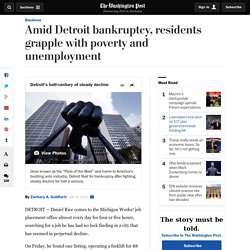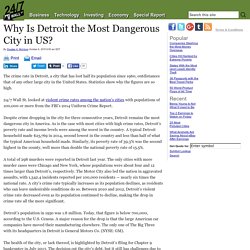

Detroit Race Riot (1967) The Intersection of 12th Street and Clairmount, Saturday, July 23, 1967 Image Courtesy of the Detroit Free Press Image Ownership: Public Domain The Detroit Race Riot in Detroit, Michigan in the summer of 1967 was one of the most violent urban revolts in the 20th century.

It came as an immediate response to police brutality but underlying conditions including segregated housing and schools and rising black unemployment helped drive the anger of the rioters. On Sunday evening, July 23, the Detroit Police Vice Squad officers raided an after hours “blind pig,” an unlicensed bar on the corner of 12th Street and Clairmount Avenue in the center of the city’s oldest and poorest black neighborhood. At 5:20 a.m. additional police officers were sent to 12th Street to stop the growing violence. Around 1:00 p.m. police officers began to report injuries from stones, bottles, and other objects that were thrown at them.
At 2:00 a.m. Sources:Allen D. Squatters slow Detroit's plan to bulldoze vacant homes. Autoplay Show Thumbnails Show Captions Chris Mathews' crew showed up this month to demolish one of the thousands of vacant homes destined for demolition as part of Detroit's grand plan to bulldoze its way to prosperity when a call from his office stopped them in their tracks: Someone was living there.

Detroit’s DIY Cure for Urban Blight. DETROIT—For the past year, Clement Wright has driven into the Marygrove neighborhood before and after his night shifts at Chrysler to reclaim a small piece of the city where he has spent his whole life.

While his friends texted him sunny vacation pictures from the Florida Keys, Wright, 62, spent much of his non-working life tearing down walls, laying bricks, installing electrical outlets, sanding, tiling, nailing, molding and painting. “When I got it, it was devastated,” says Wright, standing near a shop vacuum and a roll of pink insulation in his three-bedroom, brick colonial built in 1950. Dozens of houses like it had gone vacant in this tightly-packed middle-class neighborhood near Detroit’s Marygrove College. “The house had been sitting seven years.
Detroit Is Now a Charity Case for Carmakers. Purdue's Online Writing Lab (OWL) Amid Detroit bankruptcy, residents grapple with poverty and unemployment. DETROIT — Daniel Rice comes to the Michigan Works!

Job placement office almost every day for four or five hours, searching for a job he has had no luck finding in a city that has seemed in perpetual decline. On Friday, he found one listing, operating a forklift for $8 to $9 an hour. He’d happily take the work, even though it pays a third less than he made building axles for Chrysler before his factory shuttered two years ago. He hasn’t been employed since. Why Is Detroit the Most Dangerous City in US? - General Motors (NYSE:GM) The crime rate in Detroit, a city that has lost half its population since 1960, outdistances that of any other large city in the United States.

Statistics show why the figures are so high. 24/7 Wall St. looked at violent crime rates among the nation’s cities with populations of 100,000 or more from the FBI’s 2014 Uniform Crime Report. Detroit's Staggering Murder And Violent Crime Rate Are 'A Public Health Issue' Following news that Detroit was exiting bankruptcy and officials talking with optimism about the road ahead, grim new statistics drive home how much there is to do before the city’s future truly appears bright.

Detroit has the highest murder and violent crime rate of any major city in the country, according to the FBI. FBI Uniform Crime Reporting statistics released Monday show that Detroit logged 316 murders and non-negligent manslaughters last year, with a rate of 45 per 100,000 people. That’s the highest of U.S. cities with more than 200,000 residents and 10 times the national rate. The city also had 14,500 total violent crimes in 2013. The report defines murder and non-negligent manslaughter as the “willful (non-negligent) killing of one human being by another.” However, violent crime is no stranger to residents — and youth — in the Motor City. Billions in Debt, Detroit Tumbles Into Insolvency. Detroit Bankrupt: To See Detroit's Decline, Look at 40 Years Of Federal Policy.
White Flight - How Detroit Lost Its Way. Marilyn Salenger: ‘White flight’ and Detroit’s decline. By Marilyn Salenger By Marilyn Salenger July 21, 2013 Marilyn Salenger is president of Strategic Communications Services and a former correspondent and news anchor for several CBS stations.

An almost palpable sadness has swept across the country at the news that the city of Detroit has filed for bankruptcy. While the possibility of this had been discussed, the reality of what was once the fourth-largest city in the United States sinking to such depths is disheartening, a moment people will remember for years to come. To understand that the decline and bankruptcy represent so much more than dollars and cents requires a step back to a time that many would prefer to forget but remains unforgettable. In the late 1960s,racial tensions engulfed parts of our country, at the cost of lost lives and abject destruction. It was the beginning of the ending we are now seeing for a city that once stood tall with head held high. Opinions Orlando Shooting Updates post_newsletter348 follow-orlando true. Anatomy of Detroit’s Decline - Interactive Feature. Mayor Coleman A. Young of Detroit at an event in 1980. Richard Sheinwald/Associated Press The financial crisis facing Detroit was decades in the making, caused in part by a trail of missteps, suspected corruption and inaction.
Here is a sampling of some city leaders who trimmed too little, too late and, rather than tackling problems head on, hoped that deep-rooted structural problems would turn out to be cyclical downturns. Charles E. Edward Jeffries, who served as mayor from 1940 to 1948, developed the Detroit Plan, which involved razing 100 blighted acres and preparing the land for redevelopment. Albert Cobo was considered a candidate of the wealthy and of the white during his tenure from 1950 to 1957. Coleman A. Kwame M.